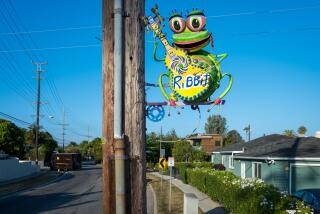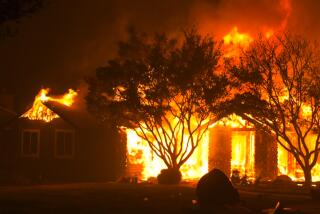Six water mains break in L.A. on day DWP’s chief seeks rate hikes
As utility crews raced Tuesday to repair six water main breaks that stretched from the Hollywood Freeway on the east to La Cienega Boulevard on the west, the general manager of the Department of Water and Power stood before the agency’s Board of Commissioners and requested a series of steep rate increases over the next two years.
Ron Nichols, who first argued for increases last summer, said a 5% water rate hike and a 10.5% electrical hike over two years were critical if the department hoped to comply with environmental mandates, renovate its coastal power plants and accelerate the replacement of water mains throughout the city.
“There’s a fair amount that we have not attended to, and it’s catching up with us,” Nichols said.
That was slim solace for residents of the city who experienced an interruption of water service when the system began failing about 1:30 a.m.
By the time morning commuters were getting on the road, the DWP reported breaks in six neighborhoods, all within 3 1/2 miles of each other. The disruption of service resulted in more inconvenience, however, than damage.
The breaks were attributed to an inspection of the Lower Franklin Canyon Reservoir. DWP spokesman Joseph Ramallo said the agency needed to close the valves leading into and coming out of the reservoir in order for divers to work in the water.
To compensate for the loss, the department switched to another water source, which caused a spike in water pressure throughout the region along the Hollywood Hills. The DWP, which expects to finish its inspection and repairs on the reservoir by Friday, said changes in water pressure expose weaknesses in the cast-iron pipes that run under the city and lead to ruptures.
Four of the breaks were repaired by 1 p.m., and the other two were fixed by early evening.
The most disruptive break occurred at the intersection of West 3rd Street and South Fairfax Avenue and resulted in the closure of 3rd Street across from the Farmers Market.
Mark Panatier, vice president of marketing and development for A.F. Gilmore Co., the company that owns the popular retail complex, showed up for work at 7:30 to find crews mopping up and excavating the street in order to find the broken 8-inch water main.
“We’re lucky it was Tuesday,” he said. “Most of our visitors come on the weekend.”
The market, according to Panatier, is served by two water systems, so its businesses were able to stay open. Only Starbucks was left without water.
Less than a mile away, DWP customers on North Vista Street were having a more difficult time adjusting. By early morning, water and mud were rushing down their street.
Rachel Balter was inconvenienced by the break, which led to the loss of water. With Passover on Friday, Balter called it “a real problem. We can’t do any cooking or cleaning.”
Broken water mains are nothing new for the DWP, which averages four to five breaks a day in a system with nearly 7,200 miles of water lines. More than 500 breaks were recorded in January 2007 and more than 250 last December when extremely cold weather exposed weaknesses in the pipes.
It was last June when Nichols first took his argument for rate hikes to nearly three dozen community meetings. The proposal, though, was put on hold when members of the City Council said they would not approve any increases until the city hired an independent representative to scrutinize hikes in water and electricity bills, a position created by a voter-approved City Charter Amendment.
In January, the council named energy consultant Frederick Pickel to the office. He said that he was still hiring staff and may not be able to finish his analysis of the DWP proposal as soon as the utility would like. “I just saw these rates an hour ago,” he said, adding that the analysis may not be completed until June.
The water main that broke at 3rd and Fairfax dates to 1949, according to DWP District Superintendent Breonia Lindsey.
“That’s not something that we can continue sustaining,” said Nichols in an interview. “We’re a 100-year-old utility, and we have been playing catch-up on funding and budgeting for a number of years.”
The rate increase would allow the department to replace about 150,000 feet each year.
The timing of Tuesday’s water main breaks and the rate hike proposal caught the attention of City Councilman Mitchell Englander.
“I always find it fascinating that right before rate hikes are proposed, something major happens — like water [main] breaks,” said Englander. “I don’t understand why the engineers aren’t working to make sure we have a smooth system. Even though the system is old, it can still handle the capacity. We only have issues when they change things.”
Los Angeles Times staff writers Martha Groves and David Zahniser contributed to this report.
More to Read
Sign up for Essential California
The most important California stories and recommendations in your inbox every morning.
You may occasionally receive promotional content from the Los Angeles Times.












